2025-12-20 21:02:33
Lots of interesting stuff, just jump to what’s interesting to you! Today:
Were the Dark Ages actually dark?
What we’ve learned about US history: civilizations older than Egypt, super early settlements, the role of silver in the US’s independence, how the US kick-started its industries, and how that influenced the North-South war.
When Spain wanted to conqu…
2025-12-19 01:34:12
This is the quarterly review of all the new learnings on GeoHistory topics we’ve covered.
Today:
The Future of Nation-States: How countries are overspending and trying to tax the rich, who flee, while state control is becoming flimsier by the day.
Cities: A new one, what we’ve learned about the existing ones, SF, and how specialized cities must be to thrive.
The latest on the Israeli-Palestinian conflict. Hint: Not looking good for the long term.
Later this week (premium):
Were the Dark Ages dark?
What we’ve learned about US history
When Spain wanted to conquer China
The importance of transportation
And more
One of the big themes of Uncharted Territories is how the entitlements that Western countries have committed to are incompatible with the wealth concentration and uprooting allowed by the Internet, AI, and crypto. Overspending states will try to tax rich people, but these are quite mobile, and therefore, hard to tax. Recent news has been confirming this thesis.
In Europe, if a company pays €60k per year for your services, how much of that do you keep?
In countries like France or Italy, you barely keep 40%. Most of what you make goes to the government! How much more can they tax? I argue not that much. They’ve already maxed out what they can take.
Of course, they’ll try to get more, and the go-to victim is rich people. Alas.
Storonsky is just one example of many.
This follows a recent increase in UK capital gains taxes, from 10% to 18% for standard gains, and from 20% to 24% for high earners.
Quick back-of-the-envelope calculation of the ROI of this move:
Storonsky owns 18% of Revolut.
Say it’s worth $200B when it goes public.
That’s $36B ownership.
If he were to sell, the UK capital gains bill on this would be 24%, or $8.5BN.
In the UAE, it will be $0.
Over 8 billion dollars for a change of residence sounds like a nice ROI. For Storonsky. For the UK, it’s devastating. But it’s just the beginning of their weakening grip.
States control the land. If something is connected to the land, states can track it, demand payments, and send their guns to enforce their demands. So real estate, energy generation and transmission lines, airports, roads, telecom cables… All of these are their tools of power. Tools like remote work and solar energy are their enemies.
SpaceX’s Starlink is the tool that will untether communications. And they’ve recently moved one step closer to this vision: As I mentioned recently, they’ve just trademarked “Starlink Mobile” and they’ve bought a bunch of mobile spectrum to operate in the US—probably the first of many countries for which they will do this.
Can states still control telecommunications in this scenario? What if, say, a country like Iran tried to block mobile access the way they tried to block Starlink Internet?
For a direct satellite-to-cell operation to work, you need the satellites, the frequencies to emit the communication, the devices, and some land facilities like network operations centers and gateways.
Governments like Iran can’t control the satellites. They will be able to emit in this new spectrum (the range of frequencies Starlink just bought) in 2 years.
Devices need to be able to handle the same spectrum. Today, phones don’t support the spectrum SpaceX has bought, but SpaceX is working on phone makers enabling it. Musk claims it will also be a reality in two years.
Theoretically, governments could block the sale or ownership of enabled devices, but it would take a forward-thinking government to do this. I guess China could do it, but I’m skeptical any other will.
Alternatively, Starlink could bypass this by illegally using spectrum it doesn’t own, if no other company is using it. I assume, as a rule of thumb, most countries have more spectrum than they’re using. If Musk is forward-thinking, he will enable satellites to handle a broad array of frequencies.
Countries could jam the frequencies Starlink uses, but that would cost billions of dollars in jammers. It would probably only be possible in big cities, so people who want to bypass their government’s control would simply live elsewhere.
These don’t need to be in any specific country, they can be in neighboring ones, so no control here.
That leaves physical control as the only tool states have to control direct-to-cell communications. It’s basically like what Iran did to suppress Starlink Internet during the war with Israel, trying to jam the satellite internet in urban areas, and spot and confiscate the devices. I’m sure they caught some people, but I doubt they suppressed it. With direct-to-cell, it’s the same thing, except there are no dishes to spot, only phones. And you have to be able to distinguish satellite connected phones from the rest. Almost impossible.
Note that none of this applies to a country like the US, though, because the US controls SpaceX, but also Apple, Google, Qualcomm… It could intervene at any of these layers. But this state capacity is not shared by most other states. Overall, it sounds to me like this will dramatically undermine the power of most1 nation-states: They won’t be able to stop their citizens from communicating anymore!
Another big consequence of the End of Nation-States is that all citizens will be able to understand each other better, so ideas will flow across countries, and people from different countries will feel much more like each other than today. A few years ago, I thought this would happen through everyone learning English, but I’m less and less sure. It looks like AI translation is becoming frictionless faster than people are learning English.
With direct-to-cell communication, people won’t even need a Starlink device to surf the web or talk to anyone, anywhere on Earth. And the grip of governments will grow even looser still.
The pattern that emerges from the 40 or so articles I’ve written about cities is that there’s a science behind the good ones, but we’re mostly unaware of it. We don’t know what makes cities appear and thrive. So every time we discover a new factor, I pay attention. Like noise.
How do you quantify the cost of noise to society? This paper did it intelligently: It looked at how much people were willing to pay to live in a calmer area. How? They looked at the prices of homes along noisy thoroughfares before and after the construction of noise barriers.2 After they were built, prices became 7% higher than in areas with no noise barriers. In other words, people were willing to pay a 7% premium to live in less noisy areas. Researchers estimated that, considering all the real estate value across the US, the cost of noise was $110B! What would be the equivalent cost if applied to cars? Nearly $1,000 per car per year! That’s what cars should pay on average if they covered their externality, the negative impact of their noisy existence.
Luckily, electric vehicle engines barely make any noise, so their use will improve the quality of life in cities. However, that’s only true at low speeds:
Starting at ~40-50 km/h (~25 mph), most of the noise a car makes comes from the rolling, not the engine roaring. For trucks, that comes later, at around 60 km/h (~40 mph). Which means that small roads and streets will have much less noise than today, but highways won’t.
The amazing Jan Sramek and his California Forever are building the most exciting new city in the West. They’ve just submitted concrete plans for incorporation.
It will include Solano Foundry (America’s largest manufacturing park), Solano Shipyard (the largest shipyard3), and walkable neighborhoods for 400,000 Californians.
I’ve talked with Jan in the past. He’s one of the most joyful, optimistic, intelligent, driven founders I know. His vision is very ambitious.
More importantly, I think his plan will work. He’s been at it for a long time, and the last time we spoke, it seemed like he had finally figured out how to navigate the political side of city-building.
More on this plan here.
This new paper looked at a measure they called coherence: How concentrated cities’ economies are.4 They found that big cities are well diversified, but small cities’ economies are not. Those tended to be highly concentrated in one or a few industries. As cities grow, however, they diversify, for example, moving from craftsmanship to engineering and manufacturing.
This resonates strongly with everything we’ve seen in Uncharted Territories: Unmistakably, big cities today started as specialized small cities. These specializations tended to be around trade. For example, since Chicago is the trading hub between the Mississippi Basin and the Great Lakes, it specialized in the transportation and trade of the local commodities: beef, wheat, corn, and timber. From there, it started diversifying into more and more industries.
This has a lesson for new cities: You gotta have some specific industry you’re catering to, and focus all your attention on that. The more concentrated your industry cluster, the stronger you will be.
The only cities that should focus on diversification are those that are quite big, but still heavily concentrated in too few industries. Dubai went from oil to transportation, from there to trade (of the transported goods), to finance (of the trades), and from there to other industries like real estate, healthcare, and education. Detroit and Pittsburgh were not diversified enough, and they suffered when their industries collapsed.
In light of this, is California Forever’s plan a good one? I guess the manufacturing foundry and shipyard make sense, but are they similar enough to feed each other? Maybe it’s too diversified already? What makes CF unique is that it’s a satellite city (to San Francisco and Sacramento), so it could quickly attract enough people to cater to both industries. Maybe that makes the double focus sensible. What do you think?
Speaking of California cities, I love this image.
In my 10-part series on Israel and Palestine, I concluded that the conflict would only be resolved when Palestinians wanted peace. So how’s that going?
The Palestinian Center for Policy and Survey Research (PCPSR), a pretty neutral Palestinian non-profit, has just released an update to its polls.
A majority of Palestinians support Hamas’s attack on Israel on October 7th 2023.
When you look at Gaza, you could see a huge support just after the events, but support cratered as Israel methodically destroyed Hamas, and with it Gaza.
It seems like support is increasing as things have calmed down.
What would you conclude from this?
One could imagine most Palestinians being against the original attack, and as Israeli destruction has rained upon them, their hatred and desire for vengeance would have increased. Instead, we’re seeing the opposite: They supported Hamas… As long as they thought it was winning. As it appeared to lose, support cratered. Now that it seems like they might survive in power, their support increases. Might makes right.
If this were true, and we took it to its logical conclusion, the end of the conflict will only come when one of the two sides fully prevails.
Let’s see more data from that report. More than half of Palestinians don’t support the two-state solution.
This means that what they support is Arab Palestinians controlling the entire region, as in the elimination of Israel. 40% still support armed struggle.
If that sounds radical to you, note that this is a pretty typical interview with Palestinians.5
Ergo there won’t be peace in Palestine.
The Arab / Hashemite king of Jordan, who is no friend of the Palestinian leadership—because after the country hosted them, they tried to organize a revolution—thinks no international peace troops will ever enforce non-violence in Gaza.
So my hopes on the conflict remain as high as ever: There will be no peace in Palestine in the next few years and decades.
I hope at some point, my idea of intervening in Palestinian (and Israeli) education and culture won’t seem so naive. It’s either destruction or reeducation.
China, and maybe some other high-state-capacity countries, might also be able to.
It controls for other aspects by looking at barrier construction events, and comparing the places where barriers were not erected on that road vs other places where they were. There’s obviously a small confounding factor but I think it’s probably minimal.
In terms of land surface, it will be more than twice as big as the 2nd in the US.
They measured this through data like how closely related the industries of random pairs of workers were.
This comes from The Ask Project, which has hundreds of videos like this. I’ve seen many dozens, and this is the norm, not an outlier. I don’t understand Arabic so I can’t judge that part, but the English part is quite unbiased. I’ve watched dozens of interviews with Israelis too, and the questions are usually quite similar, if not identical, and the pushback seems equivalent on both sides. It also corresponds to the interviews I carried out myself in the West Bank. So unless somebody brings evidence, I will consider The Ask Project quite unbiased, and those attacking it without data as biased.
2025-12-12 22:57:31
It’s time for the quarterly magazine. In the coming days, I’ll be sending a few smaller-than-usual articles on all the news relevant to topics we’ve covered in Uncharted Territories. Today, I’ll share eight thoughts on a topic I’ve touched in many conversations behind doors across the world this quarter: the shifting of power between China, the US, Russia, and the EU.
After the Network States Conference this year (I’ll write about it in the future), I went to visit Srinivasan at his Network School in Forest City, which I’ll talk about another day. As we walked around the city, we spoke at length about the future of the world. He had an interesting take: In the war with Ukraine, China will keep supporting Russia for as long as it takes.
In China’s view, it’s the perfect conflict:
The US must focus on Europe, preventing its shift to China.
It sinks Europe’s time, attention, and money.
Russia loses power, population, resources, reputation, and wealth, making it immensely dependent on China.
The longer the conflict rages, the more Russia unties itself from Europe, and so the more it must tie itself to China.
This is why Balaji predicted Russia was eventually going to prevail, or at least not lose.
Meanwhile, I had the same take on the other side. It’s unknown whether the US will continue supporting Ukraine, but if it doesn’t, I really think Europe will pick up the slack: Whereas the US’s support in Ukraine is largely a symbol of its power, for Europe it’s not a symbol, it’s very much a life-or-death situation, as illustrated by very recent history:
Hence the fact that now the US is only the 6th biggest spender on defense in the NATO alliance as a share of GDP, and all the biggest spenders share borders with Russia.1
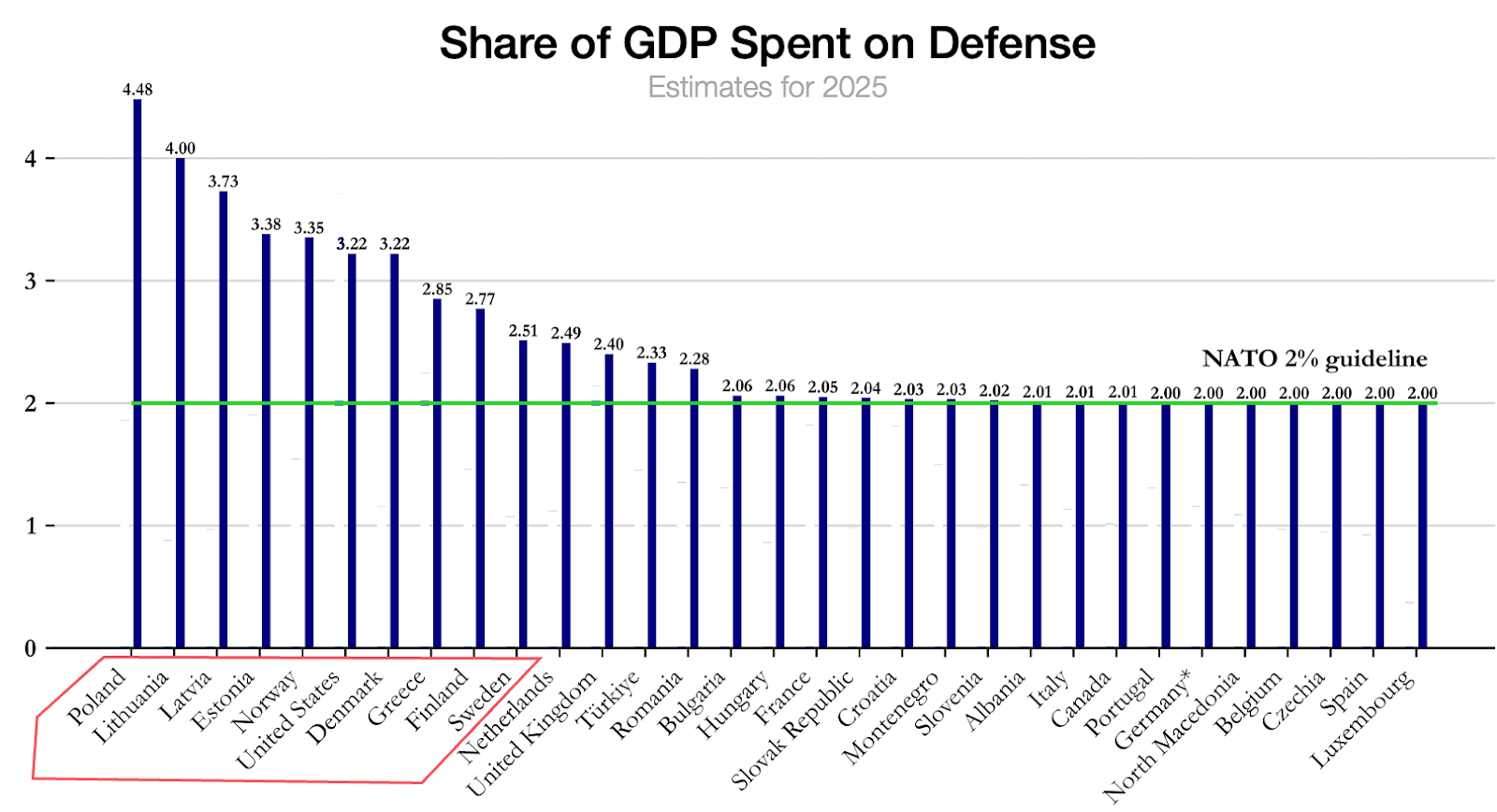
This does not bode well for the war between Russia and Ukraine, which by the end of January 2026 will have lasted longer than Russia’s involvement in WW2. Prepare for a long war of attrition. Exactly what’s convenient for China.
As we explained in this article, Russia already has a very weak grip on the eastern side of its empire, Siberia: It’s far from the capital, and transportation is inefficient between east and west.
And that grip is going to weaken as Russia weakens:
Because of the war with Ukraine
It has had a poor fertility rate for a long time already, with a population that’s been shrinking for decades
Most of its economy and government run on oil and gas revenues, which will soon disappear (I’ll talk about this in a future article)
Meanwhile, it’s not news that China is becoming stronger, and as we said, Russia is growing more dependent on China.
I found this tweet interesting:
What are these territories the Qing was forced to surrender to Tsarist Russia?
Would it stop there? I don’t think so. The same way Tsarist Russia took advantage of its superior power to take over some regions of Chinese influence, so would China do the same in the reverse situation. And it already has an excuse
Translated with this
This video, circulating in China with millions of views, claims that if Russia loses the war in Ukraine and disintegrates like it did in the 1980s, China should march northwards and take over parts of Siberia, because otherwise the US would do it, and that would be too threatening for China.
I found myself at another conference a few weeks ago, talking in private about different people’s perspectives on China: diplomats, investors, politicians, entrepreneurs… They shared some ideas anonymously, so here they are.
China annexed Tibet 75 years ago. It is in the process of assimilating the Uyghurs from western China. Now that the US has vacated Afghanistan, China is increasing its influence there. A very well connected source in Afghanistan told me they are feeling a heavy Chinese presence on the ground.
A US diplomat said something very interesting about China’s economic prospects:
There’s this Russian saying: “In Russia, if you have money and no power, you have no money.”
The same is true in China. The only way to allocate capital well is for the private market to do it, as it has much more information and its incentives are better aligned than the government’s. But for private markets to allocate money, they need to be sure that money will remain theirs, have long-term assurances that the government won’t take it. This would mean the Chinese Communist Party (CCP) would have to relinquish power (the power to seize economic assets and redirect the economy). The CCP will never do that, so the private market won’t invest efficiently.
I thought the Belt and Road Initiative (a global economic and infrastructure strategy to connect China with its trade partners) was shrinking every year, but no, that was a COVID thing. It’s reaching new records:
Initially, I thought it was destined to fail: So much money hastily invested around the world could only fail. I’ve changed my mind. These investments make a lot of sense:
They increase China’s influence around the world.
They increase China’s military presence around the world.
They allow it to bypass US choke points in the sea, notably the Strait of Malacca, through which most of China’s oil circulates.
China has construction overcapacity. These deals allow the country to keep building with this overcapacity.
They diversify China’s investments.
This is especially valuable because China used to buy a lot of US debt with its trade surplus, but that made it dependent on the US, so China has been shrinking its US treasuries for over a decade.
A US investor in Africa said something that I had never heard before:
Chinese people go to Africa because they say competition is lower. Everybody works extremely hard in China and has a lot of education. They’re competing for the same jobs. They say they have no competition in Africa because, according to them, “Africans are lazy and dumb.”
It reminded me of the documentary Empire of Dust, in which a Chinese contractor complained about how the Congolese behaved at work and in managing their infrastructure. Some excerpts here:
This highlights how Chinese investment and infrastructure will continue in the future, but also points at conflict: Economic power in the region will have to come with political power, but the last time foreigners had a strong economic and political footprint in the region, it didn’t go so well.
Meanwhile, according to a diplomat in Africa, China so far has utterly failed at conquering the hearts of Africans. They all consume US media, follow US or European sports, sing and dance to English songs, and all aspire to move to America or Europe. I’m not sure of the best way to win this battle of hearts: The US approach of making movies like Black Panther and fighting for the rights of Black people (think Black Lives Matter), or the Chinese approach of building infrastructure while berating Africans for their stupidity.
Why does this matter?
Here’s one visceral way to convey China’s demographic crash:
Contrary to many people’s beliefs, I think the US got better thanks to the competition with the USSR.
Usually, we remember the bad (especially the wars, like in Korea or Vietnam, or McCarthyism), more than the good. But there was more good. And not limited to the space race. Thanks to the competition with the USSR, the US had to make efforts to compete in ideology. It was more egalitarian, progressed more in welfare, and focused on the shiny city on the mountain more than MAGA. It courted international friends instead of putting America First. It cared more for the world and making better international institutions.
Since 1991, the US has had no rival, and the result has been more inequality, deindustrialization, less attention to international organizations, more political polarization…
But since China’s power has grown, the US is shining in the areas where there’s most competition. It’s trying to reindustrialize (eg, Build Back Better), invests heavily in AI, has given a legal framework to crypto… And we can expect the US to become a beacon of freedom in opposition to China’s authoritarianism.
Conversely, China’s century of humiliation was caused by its backwardness, which in turn was due to the fact that it had no rival in the region.
Competition is good.


Except for Greece, which has always had a big military spend to fend off Turkey. Note that Finland and Sweden were not even in NATO before the war.
2025-12-10 02:18:37
In Starship Will Change Humanity Soon, we saw how the cost of sending stuff to space is dropping, and that will enable new industries to emerge.
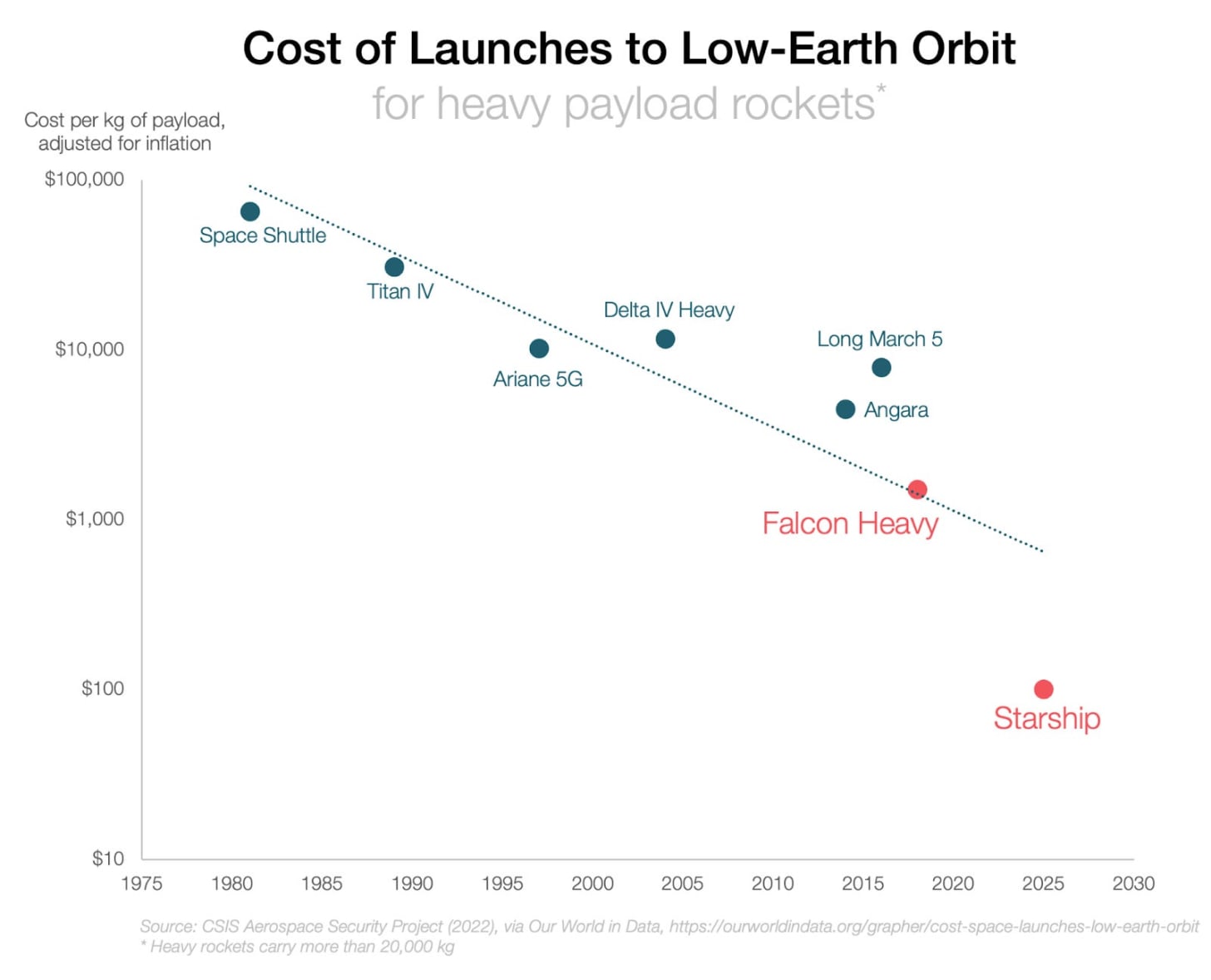
In No Room for Deep Space, we realized most of these industries will be close to the Earth, including space tourism, Earth imagery, space mining & manufacturing… Now, we’re getting specific examples of this.
Of course, the biggest example is SpaceX’s Starlink, which has just trademarked “Starlink Mobile” and it has bought a bunch of mobile spectrum to operate in the US—probably the first of many countries for which they will do this. This is leading SpaceX to a valuation of $800B.
But today, I want to look at less well-known examples:
Helium on the Moon
Pharma manufacturing
AI Data Centers
In No Room for Deep Space, I said it was not economically viable to mine anything far from Earth:
Let’s assume the cost of transportation to space is $5,000/kg, and mining there costs an additional $5,000/kg. That’s a total of $10k/kg penalty for space mining. That means you need some scarce element that costs more than $10k/kg on Earth. What elements cost more than that on Earth? Not a lot.
We would need first to find these elements in deposits so concentrated that the mining plus shipping would cost less than directly mining from the Earth. So far, we haven’t found such highly concentrated deposits anywhere.
I was wrong! We have! The 3rd one on that list.
Turns out the Moon has plenty of Helium-3! According to this paper, there is 10,000x more He-3 on the Moon than on Earth! A total of ~700,000 tons, vs the Earth’s ~30 tons. What? How come?
Our Sun shines because it fuses hydrogen into helium. Some of that helium is the more stable He-4, but some is the radioactive He-3. Some of these helium particles are expelled from the Sun in solar winds. The Earth is protected from these winds by its magnetic field and its atmosphere, which is why we have little He-3.
But the Moon has no magnetic field and barely any atmosphere! So apparently helium lands on its surface and is captured by the ground’s regolith. Wow!
So He-3 is scarce on Earth, but what is the demand for it? According to Bluefors, the company who promised to buy so much of it:
As one of the world’s largest consumers of helium-3, Bluefors utilizes it in its cryogenic measurement systems for applications in quantum technology, physics research, and the medical and life sciences industries. These systems provide the extremely low temperatures of under 10 millikelvin (sub -458ºF/-272°C), needed for the atom-stopping cold, essential for the operation and stability of qubits in quantum computers. Recent breakthroughs from companies such as Google, IBM, Intel, Amazon, and Microsoft indicate that widespread commercial adoption of quantum computing is imminent. In the coming years, the demand for helium-3 will rise sharply to power this next phase of quantum industry growth.
Bluefors leads the market with the most extensive installed base worldwide, having delivered over 1,500 dilution refrigerators and more than 15,000 cryocoolers to date.
OK so we need radioactive helium to make quantum computers (!!). Wait, it gets better! Helium used to cost something like $1M/kg, but its price has been skyrocketing.
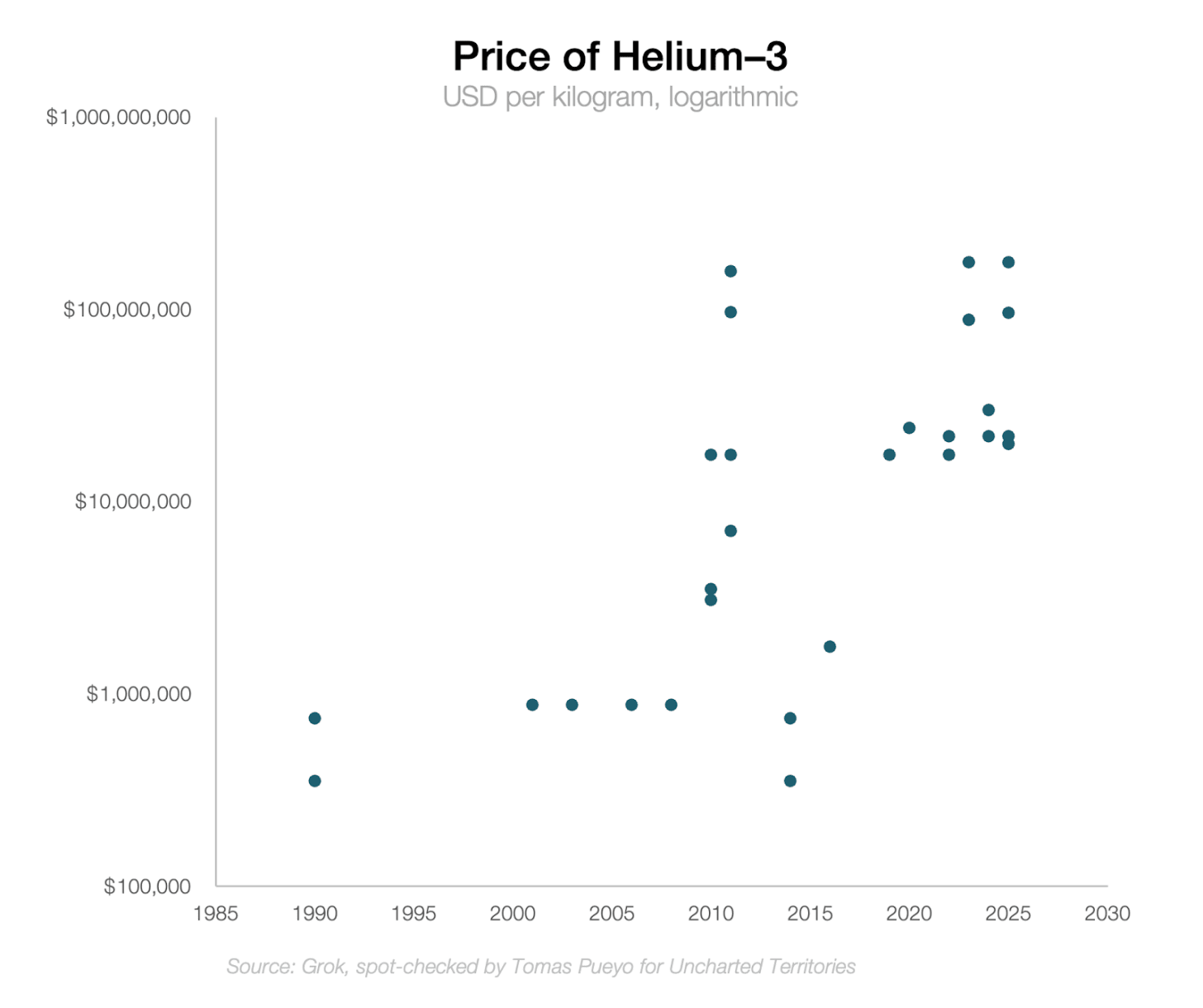
And why is that? Listen to this. Because He-3 used to be a by-product of nuclear arms programs,1 but as nuclear weapon production has dwindled, so has He-3 production on Earth.
That’s why Helium-3 costs about $20M per kg today. Now, if we start bringing a lot of He-3 to Earth, its price would shrink. But Bluefors has committed to spend $300M over 10 years for 10,000 L per year, or 100,000 L in total, which means 11.5 kg, or $26M/kg.2 My guess is they were seeing prices skyrocket, and they decided to secure them for the next 10 years by sourcing the helium from space!
In any case, if your price per kg is $26M, that gives you a lot of leeway to harvest and bring that thing to Earth. How much?
A Falcon 9 mission to Mars would cost ~$67M and could carry ~4 tons. That’s about $17,000/kg, but as of today people pay mostly to send stuff to space, so there is plenty of empty cargo space for the return. Still, let’s be conservative and assume SpaceX would charge $17k/kg. That’s less than 0.1% of the value of He-3! The trip back would not be that expensive.3 What would cost, though, is sending all the machines to the moon to operate this harvest. How much would that be?
Interlune has designed a harvester that can process 100 tons of regolith per hour.
Over 28 days, that’s 33,600 tons4, which backs out to about 0.49 kg per harvester per month.5 Two years of operation would yield about 13 kg, more than the entire cargo that Bluefors has requested for 10 years of operation.
That harvester will weigh about 3 tons.6 ChatGPT tells me you need to add 12 tons of other stuff (processing plant, solar panels, storage, radiators, cryoseparation…), for a total of 15 tons.
15 tons is three Falcon 9 missions, so about $200M.7
If all of this works well, Bluefors will be paying $300M to Interlune so that it can spend $200M of that on sending hardware to the Moon. That leaves $100M to develop all this tech and bring the helium back to Earth. Once that’s done, Interlune would have the entire thing paid for in two years, and it would then have an ongoing harvesting operation on the moon, producing millions per kg of helium.
This is freaking science fiction, but it sounds like it’s happening, and it’s worth summarizing.
We are building quantum computers, for which we need cryogenic cooling that only one element, Helium-3, can provide. Until now, the only place we could harvest it economically was from aging nuclear warheads, and it cost millions per kg. But as nuclear arms have dwindled, the price of that element has skyrocketed to tens of millions per kg, so we’re trying to figure out where to get the damn stuff. It turns out there’s a lot of it on the freakin’ moon. It has accumulated there over millions of years because that’s precisely what the Sun produces when it fuses hydrogen and then sends it flying through space. We don’t catch it because Earth has an electromagnetic shield and an atmospheric shield, which the moon doesn’t have, so the Moon bakes the helium into its soil. We’re now about to send lunar harvesters via reusable rockets so that they can automatically harvest the helium with energy from solar panels, but only two weeks at a time because of lunar cycles.
Fuck. Yeah.
2025-12-06 02:57:32
What was the first metal humans used? You probably won’t guess it.
What did the first metals have in common? It will blow your mind.
What metal promoted the first intercontinental trade?
How did this lead to the first civilizations?
How did its replacement usher in a radically new world?
The stages of human civilization after the Stone Age are the Copper Age, Bronze Age, Iron Age… Why these materials? Why did the Copper Age come first? Why did the Iron Age come later? What came after that? Why did we discover some metals before others? What did each enable? How did the order of metals we discovered influence human history?
These are the questions we’re going to answer today: How metals shaped our early civilization—because they determined the types of tools humans could use, and the civilizations we could build with them.
Ready for the first metal humans discovered and used? Gold!1
Whaaaat!?
OK here’s another crazy fact: The first three metals that humans discovered were gold, silver, and copper, probably in this order, and here’s how they appear in the Periodic Table.
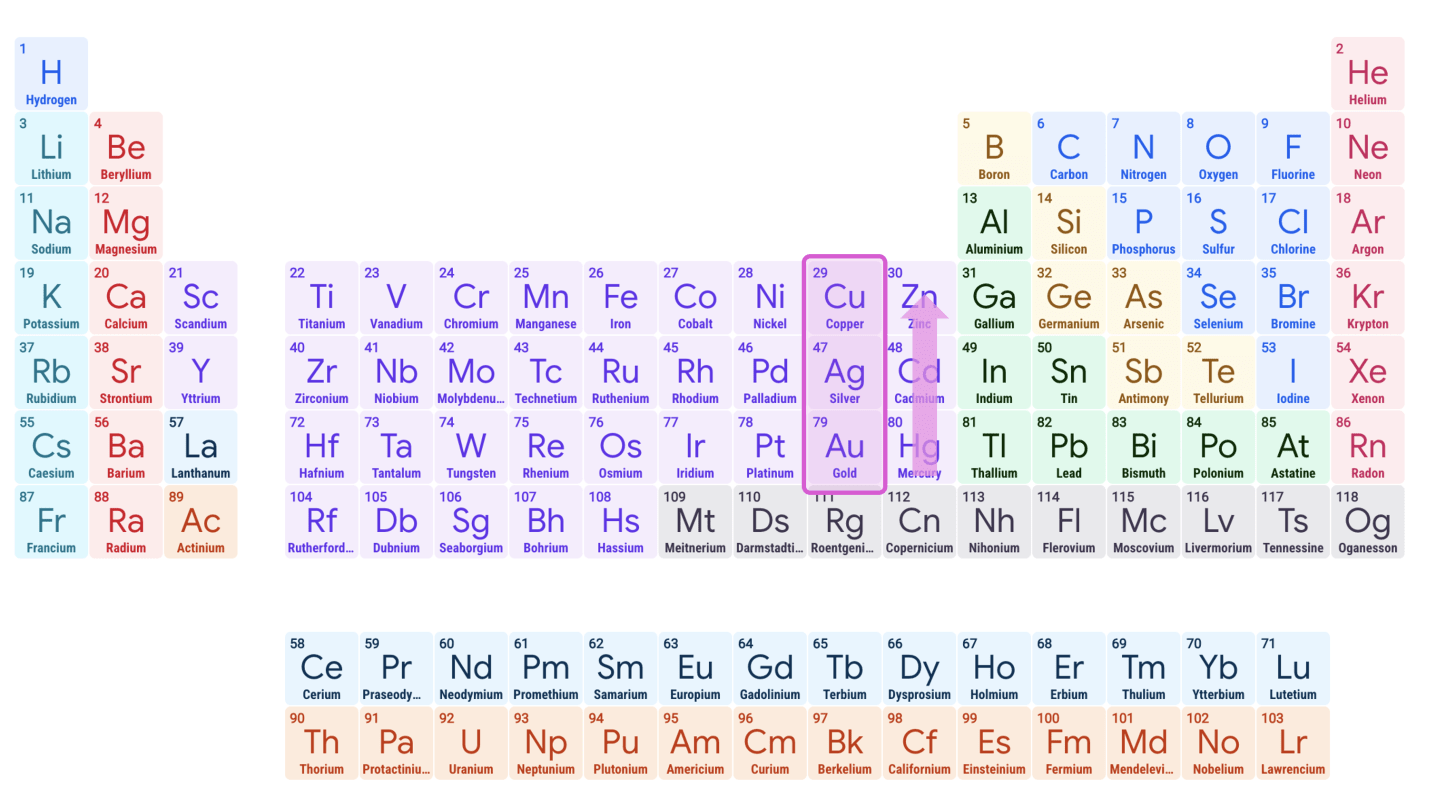
After your head explodes, you should put it back together and wonder: IS THAT A COINCIDENCE?? I think not. I can hear your brain gears turning: What do they have in common? How did that make them the first metals? How did that determine the history of humans? And then: Oh God, is Tomas going to mix history, geography, physics, geology, and chemistry again? Why yes, yes I am.
But fear not, for I will hold your hand through these scary landscapes and by the end of this article, not only will you better understand the history of humanity, but you’ll also learn some physical and chemical properties of crucial metals for humanity: gold, silver, copper, lead, tin, bronze, iron, and steel.
What the first three have in common—gold, silver, and copper—is that all are native metals: You can find them in their pure form in nature!

How come primitive tribes carried gold as jewelry and not other metals? Here’s a clue:

Here’s another one:
Yes, ancient humans just stumbled upon gold! What a crazy gift from nature! A metal that is valuable because it’s malleable, doesn’t oxidize, is found in nuggets, with a distinctive shiny yellow color to make it easy to find, and a heavy weight to help separate it from rocks in a pan!
How is that possible? you wonder.
In the Earth’s crust, liquid magma separates materials through different temperatures and pressures. Since gold is so stable, it doesn’t mix well with other materials, and when liquid with a high concentration of gold solidifies, gold veins appear.
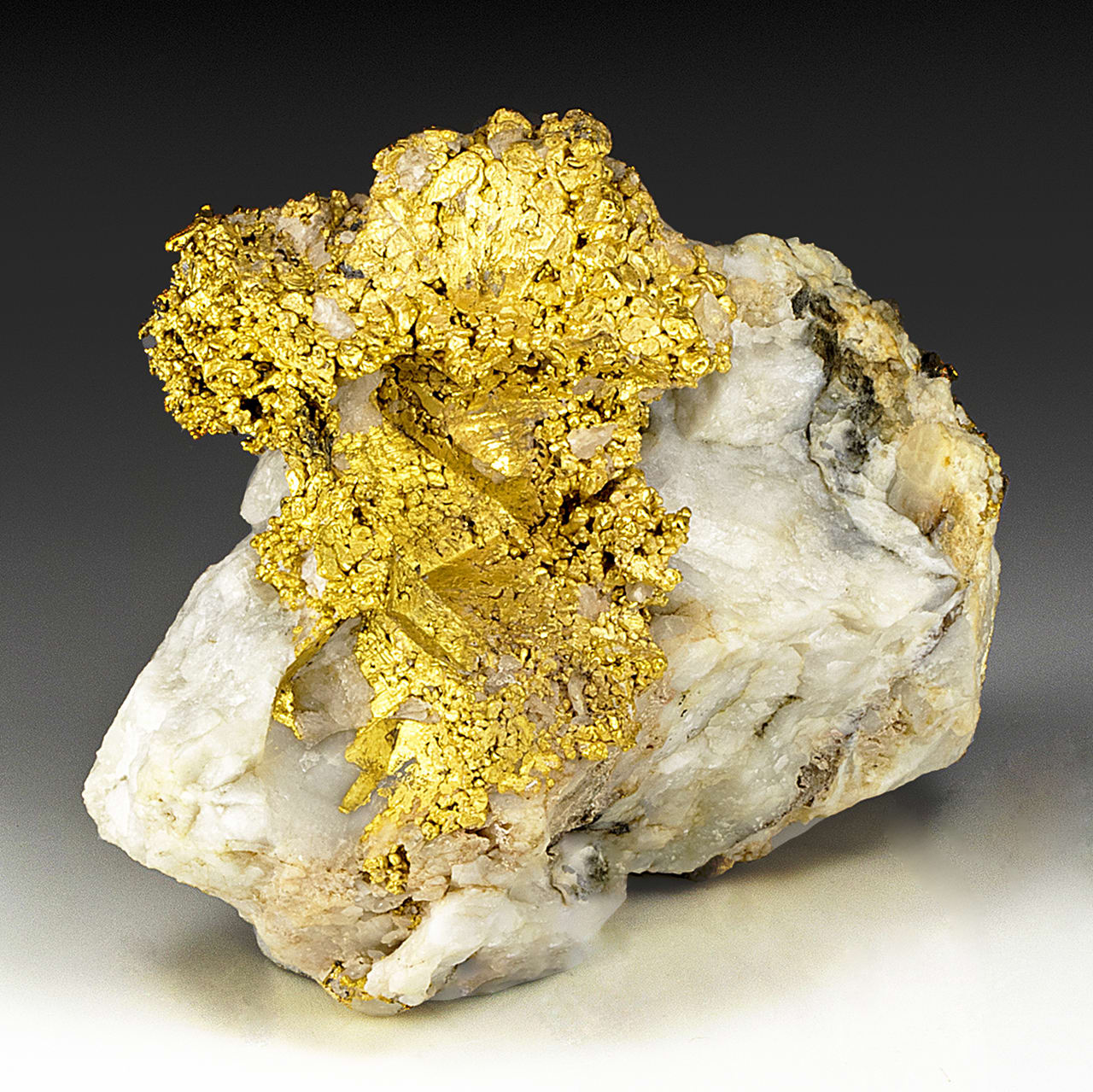
Once rocks with gold veins are pushed to the surface, erosion carries the other elements away, which are:
Easier to mix with common elements like water, oxygen, silicon…
Lighter, so easier to carry away.
This leaves behind the gold, which is inert and heavy. This is why people find gold nuggets in small mountain streams: Gold doesn’t travel too far, but it can be carried downstream by violent torrents that erode the materials around it. It tends to accumulate in quiet spots in rivers that follow turbulent sections.
So that’s why we had gold first. What about silver?
The first difference between gold and silver is that silver tarnishes.

This made it less common than gold early on, because it bonds very easily with sulfur. To form in its pure metallic form, it needs to be in an environment completely devoid of sulfur, or with agents that take the sulfur out and precipitate the silver back into its pure form.2 These are uncommon, but they exist, and form silver in small wires, sheets, and nuggets.
Given its rarity, early on it was just decorative, until we discovered how to get more of it from ore. We’ll see later when that happened.
So gold and silver were, paradoxically given their actual scarcity, some of the earliest metals to be discovered and used by humans. And what did they do with them at the time?
Gold has always been the perfect store of value, because it’s available, yet very scarce, it’s durable (it doesn’t oxidize), malleable (you can shape it easily, so you can easily mint it into coins, and it’s divisible), portable (valuable enough that it contains lots of value per gram, so you can carry lots of value with you), fungible (two pieces are the same), and it looks beautiful, with its shiny yellow color… The other reason why it was so valuable depended on how many hours of work did it take to produce one kg? The more work it took, the more value a metal could store, and gold was still very rare in native form.
However, gold is too heavy and malleable to be a tool or a weapon, so people had no actual use for it except as a store of value… That’s why gold was used as jewelry and for other decorative items: a perfect way to display your wealth.

Silver is similar, but early on it was much less abundant, and less durable because it oxidizes lightly, so it was much less widespread as a decorative element.
Like gold and silver, copper also exists in native form.
But we said before that native silver was rarer than gold because it binds to other elements more than gold. Well, copper binds to other elements even more than silver.
So we ended up in a situation where, although copper is much more common as an element than silver, and silver more common than gold, their native form is the opposite, so the order of human usage and discovery was the exact opposite!
In other words, gold was the first metal to be known and used precisely because it’s so noble: Since it doesn’t interact with other elements, it accumulated in nuggets that could be easily identified.
Meanwhile, not only is copper rarer than gold or silver in native form, but it’s also much lighter3 and harder than the others, which meant it was more coveted for tools and weapons.
So when we stumbled upon a way to make more copper instead of picking it up from the ground, we paid attention.
Most metals react too much with other elements to remain in native form. They aren’t pure. They might mix with oxygen and form oxides, sulfur to make sulfides, silicon and oxygen to make silicates…
Some of them are pretty nice, like malachite.

So people used these pretty materials among other things as pigments, some of which they used to decorate their pottery.
They already had kilns, big ovens that could reach high temperatures to turn clay into pottery, tiles, and bricks.
When they added these pigments, they might have seen copper form! Copper melts at 1,085ºC, which is higher than fire pits (400-600ºC), but a temperature some prehistoric kilns could reach. Under these temperatures, the carbon from the wood (for fuel) would bond to the oxygen, hydrogen, and other elements in the ore, and extract them. Liquid copper would be released.

Maybe ore like malachite or azurite found itself in kilns as a pigment, or maybe for some other reason, or maybe it was another type of copper ore. In fact, all of the above probably happened in different places at different times. The result was ground-breaking, though: For the first time, humans could make metal.
And this metal was extremely useful, because it’s hard enough to work as a tool like simple hoes or sickles, it could be shaped into pipes and cauldrons, it can have an edge to become a knife, sword, or arrowhead… So the discovery of copper dramatically improved agriculture, cooking, and violence, which led to a population boom and the ability to wage war.
Copper is also reasonably stable (because it’s in the Group 11 we saw before, along with silver and gold), so it could work as money, enabling more trade, wealth accumulation, and the payment of wages necessary to wage war at scale.
In other words, copper made kingdoms possible. That’s why it’s called the Copper Age.
But before we could move into the next age, we needed another couple of metals.
Lead and tin were the next two elements to be discovered.
From Pliny’s writings it appears that the Romans in his time did not realize the distinction between Tin and Lead.—Stannum Tin
Why were these the next metals? How come they were the first non-native metals to be discovered? Because you can make them in a normal fire pit!
Lead is very common in the Earth’s crust, but it’s not a very stable element. It frequently bonds with sulfur to form galena.
Lead melts at 327°C. A wood fire easily reaches 600–800°C. When galena found itself in a fire pit, it became lead!4
My guess is that humans discovered this thousands of times over their history, much before they discovered how to smelt copper. It might have kick-started the technology of smelting.
But lead is not very useful because it’s heavy and way too soft. It couldn’t work as a tool or as a hand-held weapon.
Instead, we used it to cast figurines and amulets, for cosmetics. Later, for early plumbing.
Lead is the heaviest stable element that exists, and this weight was handy for other uses. One was as a weight or a token, super useful for accounting and hence management. The other was as bullets for slings.
However, galena frequently has another metal in it: silver. As we learned to smelt lead, we learned to extract silver. Soon, the value of silver in galena passed the value of lead. This probably had a couple of consequences:
After we discovered the process of cupellation to separate lead from silver, the latter became more widespread. This allowed it to become a currency, and to facilitate international trade.
Because silver justified the smelting of galena, lead became a dirt cheap byproduct that could be used for anything worth using it for. In fact, more than a byproduct, it was a waste product. Because it was so cheap and malleable, it was used for plumbing and cooking vessels in Ancient Rome (and as an additive in wine!), and led to the theory that lead poisoning was one of the causes of the fall of Rome.5
One of the reasons that definitely contributed to the fall of Rome was the exhaustion of silver mines. Like for Chinese empires.
Back to lead. Given its early use, maybe it was the first metal humans worked with heat, and maybe that gave birth to metallurgy, which eventually led us to copper. We don’t know yet. What we do know is that another metal with some similarities to lead was the ticket to the Bronze Age.
Tin is a puny thing. Like lead, tin is malleable, reacts readily with other materials, and has an even lower melting point, at 232ºC. But tin is more brittle than lead, and much less common in the crust (generally in the form of cassiterite), so I assume random discoveries of the metal would have been uncommon, and when they happened, not found very useful. Tin did not lead to the emergence of metallurgy.
But in some copper mines, tin can be found in the same place as copper. Both metals would go into kilns at the same time, forming bronze by accident. And bronze is very useful.
Compared to copper:
Bronze is much stronger and harder. It doesn’t bend or deform as easily, enabling better weapons and armor. While copper axes dulled immediately and blades bent instead of cutting, bronze weapons endured in battle, providing an incontestable advantage to those who weaponized it. Tools lasted much longer, increasing food production.
Bronze melts at lower temperatures, 950-1000ºC instead of 1085ºC, and is very fluid, making it very easy to work. Mass standardization by pouring it into molds became possible.
Oxidized bronze is stable and protects the metal underneath. Copper oxide is flaky. That means bronze weapons and tools lasted longer.
Bronze springs back, while copper doesn’t and fatigues early. Bronze is useful for gears and springs, enabling mechanisms, while copper was worthless for that. Hinges, nails, clamps, joinery elements, valves, fittings for boats and wagons… all became possible with bronze.
In agriculture, bronze allowed us to cut trees for farmland, break heavy soils with stronger plows than wooden ones, use tools for much longer, and create irrigation systems.
Militarily, bronze enabled long, sharp swords, spears able to pierce shields, durable armor, standardized weaponry for entire armies, and so professional warrior classes, territorial expansion, centralization of force… The birth of empires.
In urbanism, it enabled large architecture, as bronze tools were able to cut stone and wood in a way that copper couldn’t. Palaces, temples, huge stone monuments, and even big buildings were impossible before the Bronze Age.
Transportation was also much easier, because without tools to work stone, you couldn’t have stone roads. Copper also doesn’t produce durable axles, properly drilled wheel hubs, rim bands for wooden wheels, pins, clamps, and rivets that hold under impact… All key technologies for wheeled carts. So no roads and no wheeled carts without bronze.
And we know how crucial transportation technologies were to the formation of empires.
This is an even better example: Without bronze, you don’t have seafaring ships. Stone and copper tools can’t cut cedar or oak into planks, so the size of ships was limited to the diameter of trees. But bronze tools could, so suddenly ships became much bigger. This is when civilization starts expanding in the Mediterranean. There are no Phoenician, Greek, or Roman civilizations without bronze.
These ships also allowed water transportation, which was the only way to transport heavy goods like wood, copper… or tin.
And tin had to be transported from afar, because it’s quite scarce.

Since bronze became vital for development and survival in war, tin became survival. So trade became survival. The scarcity of tin drove trade.
And with it… cities and kingdoms. OK hear me out, because this is nuts: This paper from 2024 argues that the first civilizations emerged not where farming was most productive, but… Where trade between farms and mines could be controlled!
The scientists looked at where the most fertile land was, for agriculture. They looked at where the mines of copper and tin were. Then, the cheapest paths from one to the other. Finally, which of these paths had the fewest alternatives. The idea was: Farmers need tin and copper for bronze tools (and weapons). They will buy these minerals from the mines, so the paths between them become juicy places to make money. If people on those roads tried to abuse their power by robbing or taxing too much, trade would just move elsewhere… Unless it simply couldn’t. These spots were the most likely to have strong cities and states. And that’s indeed what they found!
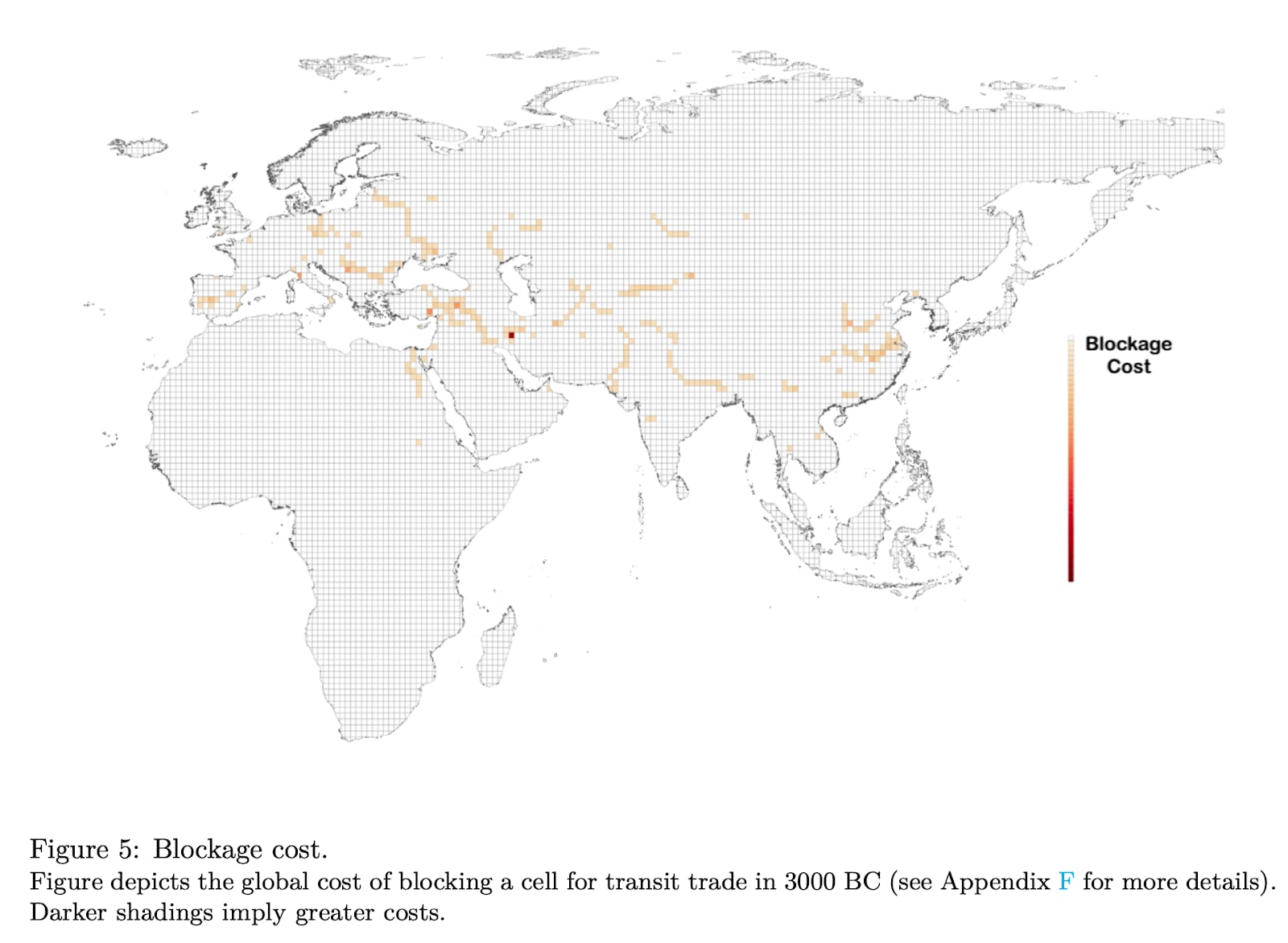
So although lead and tin are not great metals per se, their early discovery thanks to their low melting point ushered us into a golden age of civilization, maybe by showing us how to smelt ore, by providing the silver we needed to power our economies, and by allowing bronze, which allowed us to get beautiful architecture, better agriculture, stronger armies, faster transportation, international trade, and the emergence of cities, kingdoms, and empires.
The next and final step in this evolution was propelled by iron.
During the Bronze Age, very little iron was used because we didn’t know how to make it. So the only iron we had came from meteorites, like in Tutankhamun’s dagger.
Why wasn’t iron used early? Mainly because its melting point is much higher than copper, at 1,538ºC vs 1,084ºC. Copper could be smelted with much earlier kilns.
But between 1,500 and 1,200 BC, the Hittites in Anatolia (modern-day Turkey) started building bigger furnaces that reached higher temperatures. Metallurgists likely discovered it accidentally while smelting copper, using iron-rich rocks to help the copper melt. Eventually, they realized the “waste” material left behind could be forged into a new metal. Soon after, iron spread widely.
But why did it spread? Iron is harder to smelt, you also can’t work iron cold, and it’s actually softer than bronze! What’s the point, then?
A tip comes from when iron became widespread.
You see that transition from Bronze to Iron Age? You know what happened at that time, 1200 BC?
During the Bronze Age Collapse, around 1,200 BC (about when the Trojan War took place), dozens of cities were burnt, destroyed, or abandoned; sea invasions took place, maybe caused by droughts or volcanic winters.
The cause and effect are not clear, but the key to untangle this mystery is that iron is everywhere. Virtually all places on Earth have some iron ore nearby. This has radical consequences:
No need for long-distance tin trades. So if barbarians broke these trade lines, people could fall back on iron.
Conversely, anybody could now build iron weapons, so maybe it’s this wide availability that triggered the invasions of the Bronze Age Collapse.
This combines with another killer feature: With the right amount of carbon and metallurgic treatment, iron can become steel, which is stronger and lighter than iron and bronze and doesn’t oxidize as much!
And it’s actually pretty easy to make steel by accident: The same way that copper was first created copper. Remember how burning wood or charcoal releases carbon, which bonds with several elements? Well, steel is just iron with carbon.
So although iron is harder to smelt and process, and not as useful as bronze, it’s virtually everywhere, and its brother steel is much stronger and stable than bronze.
Remember all the consequences we mentioned before about bronze? Iron and steel turbocharged them:
Deforestation on a Massive Scale: Cheap iron axes allowed humans to clear dense forests into farmland.
Better agriculture: Where bronze tools were a huge expense before, farmers could now buy iron agricultural tools much more cheaply, leading to more food and bigger populations.
Mass-Armies: In the Bronze Age, equipping a soldier was expensive, so armies were small and elite. Iron allowed kings to equip thousands of peasants with shields, helmets, and spears, changing the scale of warfare forever.
Long-distance trade was not centered around tin anymore.
Construction became cheaper and sturdier, with nails, hinges, chains, tire bands for wagons, better tools for mining, for construction, for woodworking…
As the supply of wood shrunk after clearing forests, the demand increased because furnaces required lots of wood, both for high temperatures, and because the charcoal resulting from wood was the key source of carbon to form steel.
Paradoxically, the first metal humans likely handled was gold, because what makes it so valuable (mainly its stability) also makes it the most widespread native metal in nature. Alas, gold is not that great as a tool.
Those are the same reasons why the other native metals followed, why silver was likely the second, and why copper—although uncommon in native form—became so valuable: It was scarce in native form, but unlike the other metals, it could be used as a tool.
Lead and tin are also not very useful as tools because they are so malleable, but they melt very easily. This might have spurred the innovation in smelting technology that produced much more silver, which in turn enabled currencies, and for economies to flourish.
More importantly, it (or pottery kilns) might have allowed the discovery of the smelting of copper, and with it, bronze. Bronze was a game changer because, unlike other known metals at the time, it was hard enough to make effective tools. This radically transformed civilizations: For the first time, agriculture, construction, and war could use good tools at scale. Populations exploded, urban centers flourished, armies expanded.
But bronze required tin, which was scarce. So international trade became crucial—a trade that was enabled by bronze, without which seafaring was impossible, and roads and carts inefficient. This, in turn, birthed the first kingdoms, which were mainly city-states sitting at the right place to control the trade of tin between mines and agricultural regions.
Iron is harder to extract and work with, but it had two killer features that accelerated the development of civilizations: harder steel for better tools, and widespread availability. As iron and steel spread around the world, civilizations bloomed.
All this made me think of this graph:
What I don’t like about it is that it suggests that humans were poor AF for eons, until 1800 arrived and suddenly we became rich.
But whenever I look at historical developments, it’s obvious that progress is an unrelenting arrow. It’s just that technologies took substantially longer to develop. Sometimes they were forgotten and had to be rediscovered, others they compounded too slowly. But the arrow of development is unmistakable; we’ve been following it for millennia, and now it’s about to take us to the heavens to meet our hand-crafted gods, with tools we’ve built from sand6 and sunlight.
Small amounts of natural gold have been found in Spanish caves used during the late Paleolithic period, c. 40,000 BC. Gold artifacts made their first appearance at the very beginning of the pre-dynastic period in Egypt, at the end of the fifth millennium BC and the start of the fourth, and smelting was developed during the course of the 4th millennium BC; gold artifacts appear in the archeology of Lower Mesopotamia during the early 4th millennium BC.— from Wikipedia
Silver sulfide (Ag₂S) breaks down when sulfur is oxidized, and silver precipitates (becomes metallic Ag⁰) when dissolved Ag⁺ is reduced.
Look at the small number to the top left in the periodic table. It conveys how many protons this element has. Each time you add a proton, you also add some neutrons and electrons, all of which contribute to the weight of the atom. As a result, copper is 17% lighter than silver and 115% lighter than gold.
With heat, it first loses its S atom and takes an O atom. The fuel in the fire would release a C atom, that would then bind with the O in PbO, and Pb remained in pure form.
While Romans did have high levels of lead in them, the lead in the pipes was not the cause of the lead, so not the cause of the fall of the Roman Empire. Water ran constantly in Roman waterworks, and it tended to be alkaline, forming calcite that protected the lead from reacting with water. Lead poisoning happens nowadays because our plumbing stops water, and only in acidic waters.
Silicon!
2025-12-03 23:09:30
I attended the 2025 Progress Conference a few weeks ago, and learned about some crazy ideas. Here are a few highlights (I make no money from any of the following):
Neural Implants with Actual Neurons
Drone Delivery Is About to Become a Thing
Freedom of Speech and AI
[Premium only]
How Does Community Notes Succeed at Fact-Checking Where Other Mechanisms Fail?
Sam Altman and Tyler Cowen on When AI Will Manage Entire Companies
Sam Altman on Ads in ChatGPT
For the First Time, Ecoterrorists Could Stop Global Warming
Elon Musk’s Neuralink is famous for its brain-computer interfaces: They insert a small chip in your brain.
The chip interacts with surrounding neurons by inserting thin metal probes inside the brain.
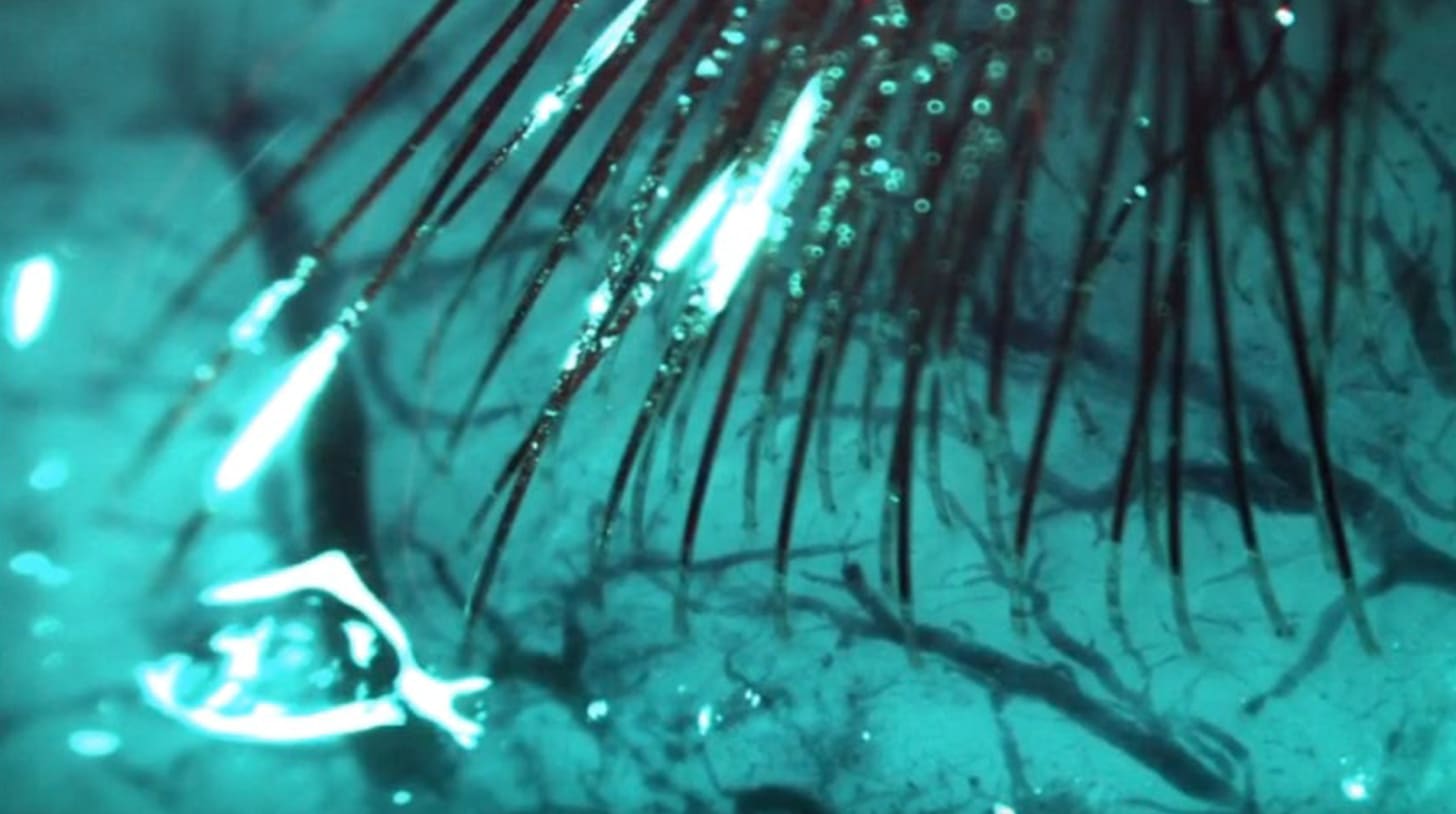
I didn’t know more companies were in the space. I visited Science Corporation, which does something similar, with a couple of differences:
Their approach is to replace the metal probes with actual neurons! Since neurons already know how to connect with other neurons, they believe that just putting lab-grown neurons in contact with natural ones will make them connect. This should be much less invasive than metal probes and allow for much denser connectivity, and hence more information exchange between the brain and the computer.
Science Corp is starting with eyes instead of tetraplegics. Lots of people lose eyesight because of problems in the retina. The company creates an artificial retina to replace the bad parts of existing ones, and then connects the artificial retina to the optic nerve with neurons.
I also visited Zipline, a company that does drone delivery.
I knew about them from when they were delivering medicine in remote areas of Africa. That sounds like a perfect use case: Infrastructure there is really bad, so valuable medication can take days to arrive. But a small plane could deliver it in a few minutes, which justifies the cost.
What I hadn’t realized is that the company is now doing standard deliveries in the US! Back in Africa, the zipline planes had a small runway and dropped the packages with parachutes.
That, of course, isn’t viable in your suburban America doordash delivery. So the company has changed its plane designs, and now they can take off and land vertically, and lower their cargo slowly with a… zip line?
The drones fly around 400 ft (~130 m), which makes them inaudible and barely visible on the ground. This altitude also makes it easier to navigate as it reduces wind gusts, which are more common close to the irregular surface of the Earth.
It can carry up to 8 lbs (3.5 kg) at 70 mph (110 km/h), which is insanely fast! Imagine ordering your burrito and burning your mouth because it got to you 4 minutes after cooking.
The company also contends this will become much cheaper than alternatives, because the thing weighs 55 lbs (25 kg) to a moped’s 200 lbs or a car’s 4000 lbs. When the vehicle carrying your delivery requires substantially less material, it should be cheaper once all the R&D is amortized and economies of scale kick in.
The weight is also going to shrink over time, as today ~35% of the drone’s mass is battery, and batteries are getting cheaper and lighter every day. The drone can do about two flights per hour (so up to 50 per day), with a max flight time of 30 minutes, with the average delivery up to 10 miles (16 km).
The company says they have just 100 planes active today, but by next year they’re going to have 15,000!! If that’s true, within a couple of years there should be more zipline delivery planes than helicopters in the world. Its main customers are going to be for medicine delivery, food delivery, and fast goods delivery: Imagine ordering your Amazon package, but instead of waiting one day, you wait five minutes!
There’s a push to regulate what AI can and can’t say. I’ve been curious about this topic over the last few years, but a couple of sessions discussing it convinced me that we need to push for AI’s freedom of speech, meaning we should prevent states from mingling in that too much.
The most convincing argument for me is that every time there’s a new tech for communications, the state tries to censor it. Of course, that happened with the Church and the states with the printing press, and with every new media since. Government censorship of AI would be especially bad because it’s so intimate and close to us. Do we really want the state to influence so heavily what we think and even how we think?
How do governments attempt to censor new media? Usually, with something that appears logical: child pornography!
Of course, who doesn’t want to protect children? There are few crimes that are more abhorrent than abusing children. That’s precisely why politicians use this, and not any other crime. If the law was called the “Reduce Petty Theft Crime Act”, and mandated to record and process all private conversations in search of evidence against them, people would be irate. So they use child pornography.
Now, child pornography is a problem. We should not minimize it. Although more than half the content is produced by children portraying themselves, the vast majority is of pre-pubescent girls. But we should deal with it like we deal with all crime. Do we let the police enter our homes without a warrant to search us? No. Then why would we do it with our personal communication?
No, this type of action is a Trojan Horse. Of course we need to be careful with child pornography,1 but we shouldn’t burn the house to roast the pig. The freedom of speech of the entire population, and thus the political freedom of a country, is more important than a few crimes, which should be tracked by professionals rather than by thwarting everybody’s freedoms.